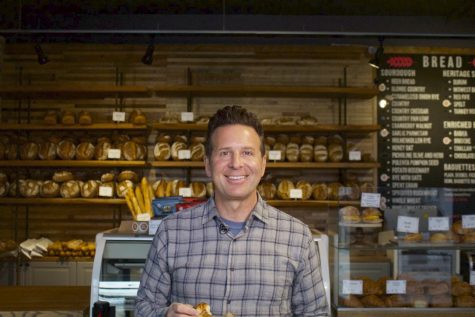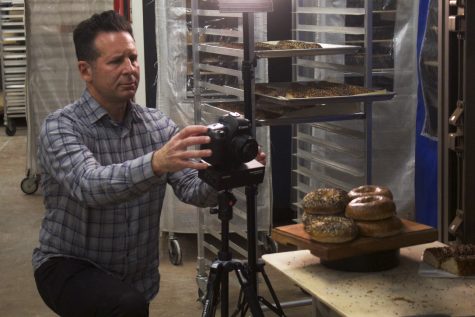Food reporter Steve Dolinsky talks favorite cuisine, working on TV and what really makes the best pizza
June 30, 2022

Editor’s note: This article is from the Communication Department’s award-winning Echo magazine.
“I was always kind of a ham as a kid,” Steve Dolinsky tells me while we sit on two benches across from each other at Hewn, a bakery in Evanston. I laugh because it makes perfect sense for a 13-time James Beard Award-winning food reporter of 25 years to use an analogy that compares himself to food.
It’s a rainy Wednesday morning in March. I was expecting to shadow Dolinsky and his camera crew while they create the food segment that will be broadcast on WMAQ-TV’s newscast next Thursday. Except Dolinsky shows up at the bakery alone, carrying a backpack and duffel bag of his own equipment, because as it turns out, “The Food Guy” on TV is the product of a one-man show.
“I always knew that I could do it, but I was never really pushed to do it,” Dolinsky says about producing his own food segments. “Now that I’ve been forced to do it, I’m fine with it.” After 17 years working at WLS-TV News as the “Hungry Hound,” along came the pandemic — perhaps the perfect push for Dolinsky to start shooting on his own.
Dolinsky sets up the lighting, camera and mic to interview Ellen King, the co-owner of Hewn. He works fast, and it only takes about 10 minutes total to set up and wrap the interview.
We spend the next hour in and around different parts of the expansive bakery kitchen where Dolinsky confidently directs bakers to stop, go or repeat movements, intently following the flow of the bread-making process through his camera lens.
Today, Dolinsky is focused on sourdoughs, baguettes and pastries, but make no mistake: He is an adventurous eater with a broad taste palette — his excitement for food is owed to a childhood spent in a kosher household.
“I grew up very regimented. You know, can’t eat this, can’t eat that, can’t have milk and meat together, no shellfish, no pork,” Dolinsky says. “It took my mom until I was a senior in high school to allow me to bring Domino’s pepperoni pizza into the house — as long as I ate it on paper plates.”
Dolinsky would visit his brother’s house, where he was astounded by the Thai and Chinese food his sister-in-law would cook and wondered, “What have I been missing my whole life?” During college, he found himself trying more international foods from Burmese and Middle Eastern cultures.
When his daughter, Madeline, was born, he and his wife, Amy, started taking her for dim sum in Chicago at only six weeks old — she mostly slept in her car seat, but they brought her so that she’d be familiar with the sight, aroma and sound. “[Madeline] grew up in a stroller in Chinese restaurants, so she asked us when she was like 2 if we were Chinese because she was so confused,” Dolinsky says.

When the Dolinskys’ two children, Madeline and Max, were 15 and 12, they took a family trip to China and Hong Kong for “the real dim sum experience,” and by then, Dolinsky notes, they were both pros, ready for their trip to Japan the following year.
While Asian cuisine remains Dolinsky’s favorite, and he always keeps ssamjang and gochujang in the fridge, the past five years of his career have led him down a “never-ending bottomless rabbit hole” of tomato sauce, cheese and dough. He recalls reading a listicle of the seven hottest pizza places in Chicago and thinking it was “total BS,” so he embarked on his own quest for the best.
Dolinsky documented his first phase of pizza research results on his website — a three-month culmination of 75 pizza places. He then wrote “Pizza City, USA: 101 Reasons Why Chicago Is America’s Greatest Pizza Town,” a book that features 101 pizza joints he recommends.
For his first book, he went to 186 different pizza places, and for his second, “The Ultimate Chicago Pizza Guide,” he visited another 40 — landing him at 226 — and that’s only counting his Chicagoland area taste tests. When all was said and done, Dolinsky took a one-month break from pizza eating.
“There’s a lot of bad pizza out there, believe it or not,” Dolinsky says. “For every three places you go to, one is going to be recommendable.”
So what does it take to earn a Dolinsky pizza recommendation or stamp of approval? “The crust always sets the tone for the pizza. It’s the base of every pie; it’s the base of every review: How good was that crust?” Dolinsky says. “When you have a really memorable pizza, it’s not because the cheese was melted properly. It’s because that crust was either crispy or chewy or crunchy or soft.”
And if you’re asking about his favorite, it’s a thin artisan pizza such as Robert’s Pizza and Dough Company in Streeterville: slightly brown, with an almost burnt bottom and a two- to three-day fermented crust.
“Pizza City, USA” is not just Dolinsky’s book title; it’s also the name of his pizza podcast and pizza tour, where he guides tourists and Chicagoans through four pizza styles at four different restaurants. His newest creation debuts this summer, with Chicago’s first-ever Pizza City Fest on July 23 and 24, featuring 40 different pizza makers (39 from Chicago and one from Nashville). The event will also serve up special guests and experts who will talk about pizza’s history.
Find your lane, be an expert in it and own it, Dolinsky says, and he’s certainly followed his own advice.
You can read the entire 2022 issue of Echo, as well as previous issues, on our website.







